Muscarinic receptor activation protects cells from apoptotic effects of DNA damage, oxidative stress, and mitochondrial inhibition
- PMID: 12538580
- PMCID: PMC1361698
- DOI: 10.1074/jbc.M212157200
Muscarinic receptor activation protects cells from apoptotic effects of DNA damage, oxidative stress, and mitochondrial inhibition
Abstract
The impact of muscarinic receptor stimulation was examined on apoptotic signaling induced by DNA damage, oxidative stress, and mitochondrial impairment. Exposure of human neuroblastoma SH-SY5Y cells to the DNA-damaging agent camptothecin increased p53 levels, activated caspase-3, and caused cell death. Pretreatment with oxotremorine-M, a selective agonist of muscarinic receptors that are expressed endogenously in these cells, did not affect the accumulation of p53 but greatly attenuated caspase-3 activation and protected from cell death to nearly the same extent as treatment with a general caspase inhibitor. Treatment with 50-200 microm H(2)O(2) caused the activation of caspase-3 beginning after 2-3 h, followed by eventual cell death. Oxotremorine-M pretreatment protected cells from H(2)O(2)-induced caspase-3 activation and death, and this was equivalent to protection afforded by a caspase inhibitor. Muscarinic receptor stimulation also protected cells from caspase-3 activation induced by exposure to rotenone, a mitochondrial complex 1 inhibitor, but no protection was evident from staurosporine-induced caspase-3 activation. The mechanism of protection afforded by muscarinic receptor activation from camptothecin-induced apoptotic signaling involved blockade of mitochondrial cytochrome c release associated with a bolstering of mitochondrial bcl-2 levels and blockade of the translocation of Bax to mitochondria. Likely the most proximal of these events to muscarinic receptor activation, mitochondrial Bax accumulation, also was attenuated by oxotremorine-M treatment after treatment with H(2)O(2) or rotenone. These results demonstrate that stimulation of muscarinic receptors provides substantial protection from DNA damage, oxidative stress, and mitochondrial impairment, insults that may be encountered by neurons in development, aging, or neurodegenerative diseases. These findings suggest that neurotransmitter-induced signaling bolsters survival mechanisms, and inadequate neurotransmission may exacerbate neuronal loss.
Figures
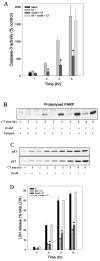
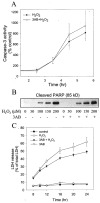
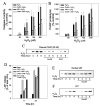
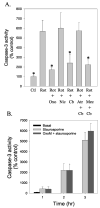
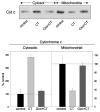

References
-
- Zornig M, Hueber A, Baum W, Evan G. Biochim Biophys Acta. 2001;1551:1–37. - PubMed
-
- Bortner CD, Cidlowski JA. Annu Rev Pharmacol Toxicol. 2002;42:259–281. - PubMed
-
- Jacobs BL, van Praag H, Gage FH. Mol Psychiatry. 2000;5:262–269. - PubMed
-
- Kempermann G. Bipolar Disord. 2002;4:17–33. - PubMed
-
- Miller FD, Pozniak CD, Walsh GS. Cell Death Differ. 2000;7:880–888. - PubMed
Publication types
MeSH terms
Substances
Grants and funding
LinkOut - more resources
Full Text Sources
Other Literature Sources
Research Materials
Miscellaneous

